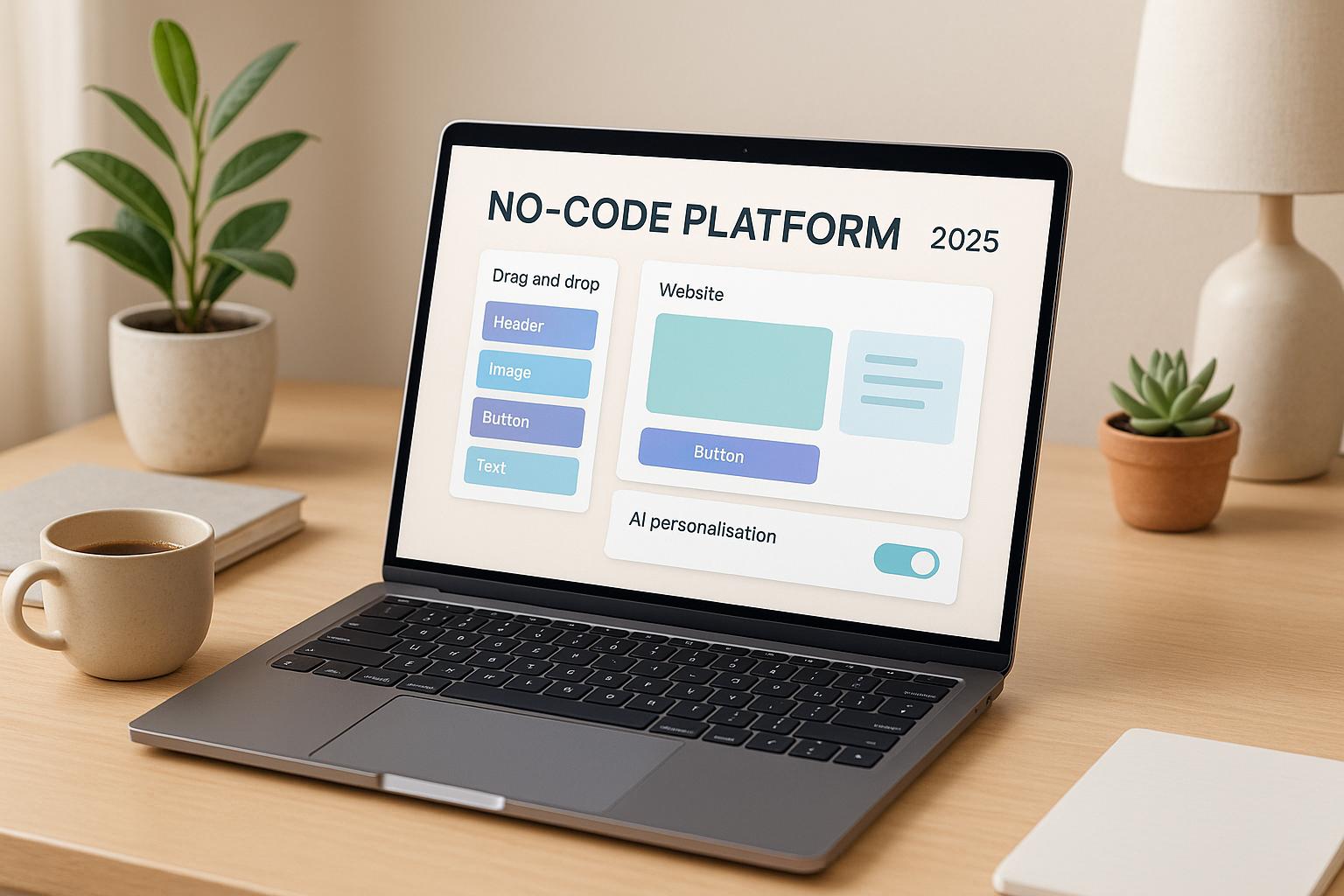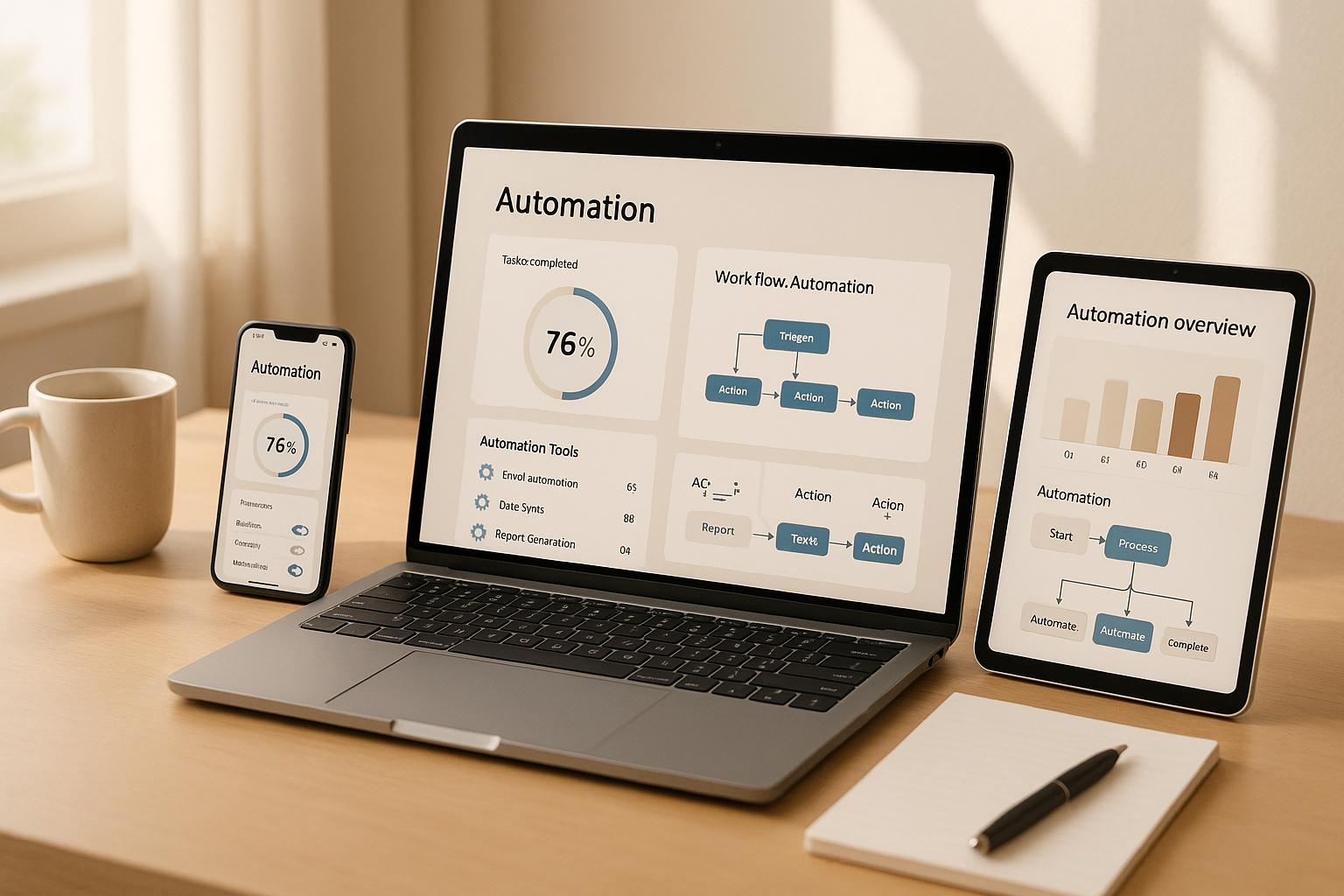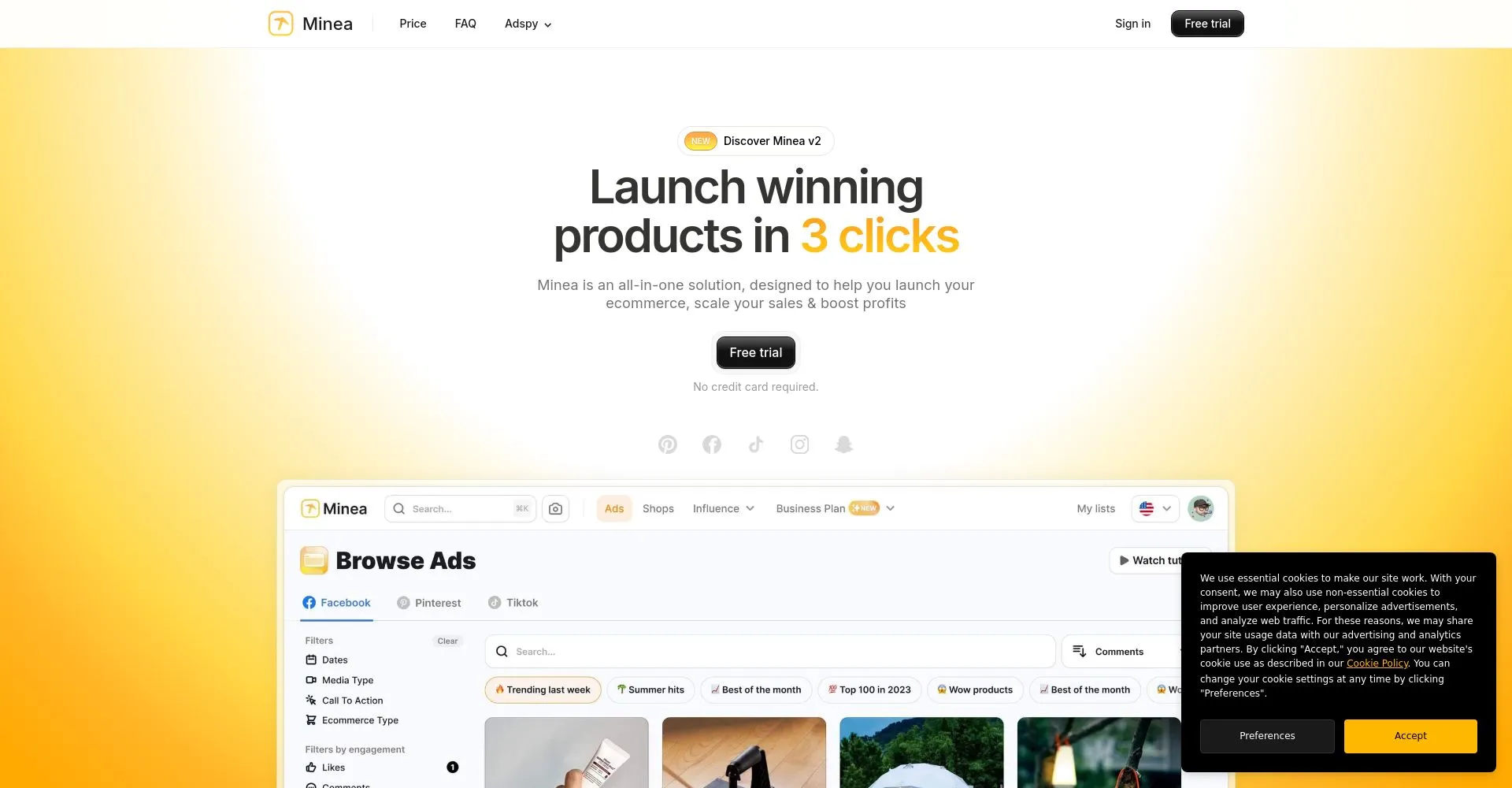Top 10 AI Usability Testing Tools 2025
By The Shed |
December 19, 2025

AI usability testing tools are transforming how teams analyze user behavior and improve digital experiences. These tools combine artificial intelligence with usability testing to provide faster insights, automate repetitive tasks, and identify patterns that might go unnoticed. Here’s a list of the top tools for 2025:
- Maze: Offers AI-driven insights, dynamic follow-up questions, and seamless integration with design tools like Figma. Pricing starts at $99/month.
- UserTesting: Combines human insights with AI to analyze user behavior. Pricing ranges from $1,500–$2,500 per seat/month.
- Optimal Workshop: Focuses on card sorting and tree testing for information architecture. Plans start at $199/month.
- Lyssna: Simplifies feedback collection with tools like five-second testing and card sorting. Pricing begins at $89/month.
- Loop11: Features AI-powered transcripts and summaries, starting at $199/month.
- Hotjar: Known for heatmaps and session recording with AI-powered analysis. Pricing starts at $39/month.
- Trymata: Offers AI-based insights and automated data tagging for $399/month.
- Axe DevTools: Focuses on accessibility testing with AI-guided tools. Free plan available; Pro starts at $45/user/month.
- Tricentis Testim: Reduces test maintenance with self-healing tests. Pricing starts at $450/month.
- Katalon TestOps: Centralizes testing with AI-enhanced analytics. Pricing starts at $54/user/month.
These tools cater to different needs, from small teams seeking budget-friendly options to enterprises requiring advanced features. Below is a quick comparison of features and pricing.
Quick Comparison
| Tool | AI Features | Pricing (USD) | Best For |
|---|---|---|---|
| Maze | Automated insights, Figma integration | From $99/month | Prototype testing, small teams |
| UserTesting | AI summaries, global participant pool | $1,500–$2,500/seat/month | Large-scale research |
| Optimal Workshop | Card sorting, tree testing | From $199/month | Information architecture testing |
| Lyssna | Click visualizations, quick feedback | From $89/month | Design validation |
| Loop11 | GPT-4 summaries, AI transcripts | $199–$399/month | UX research |
| Hotjar | AI heatmaps, session analysis | From $39/month | Behavioral analysis, conversions |
| Trymata | Automated tagging, session recordings | $399/month | Prototype validation |
| Axe DevTools | Accessibility checks, guided tests | Free; Pro from $45/user/month | Accessibility compliance |
| Tricentis Testim | Self-healing tests, AI automation | From $450/month | CI/CD integration |
| Katalon TestOps | AI analytics, centralized testing | $54–$183/user/month | Cross-platform testing |
Each tool offers unique features tailored to specific usability testing needs. Choose based on your team size, testing goals, and budget to maximize efficiency and user insights.
Best AI Usability Testing Tools in 2024
1. Maze
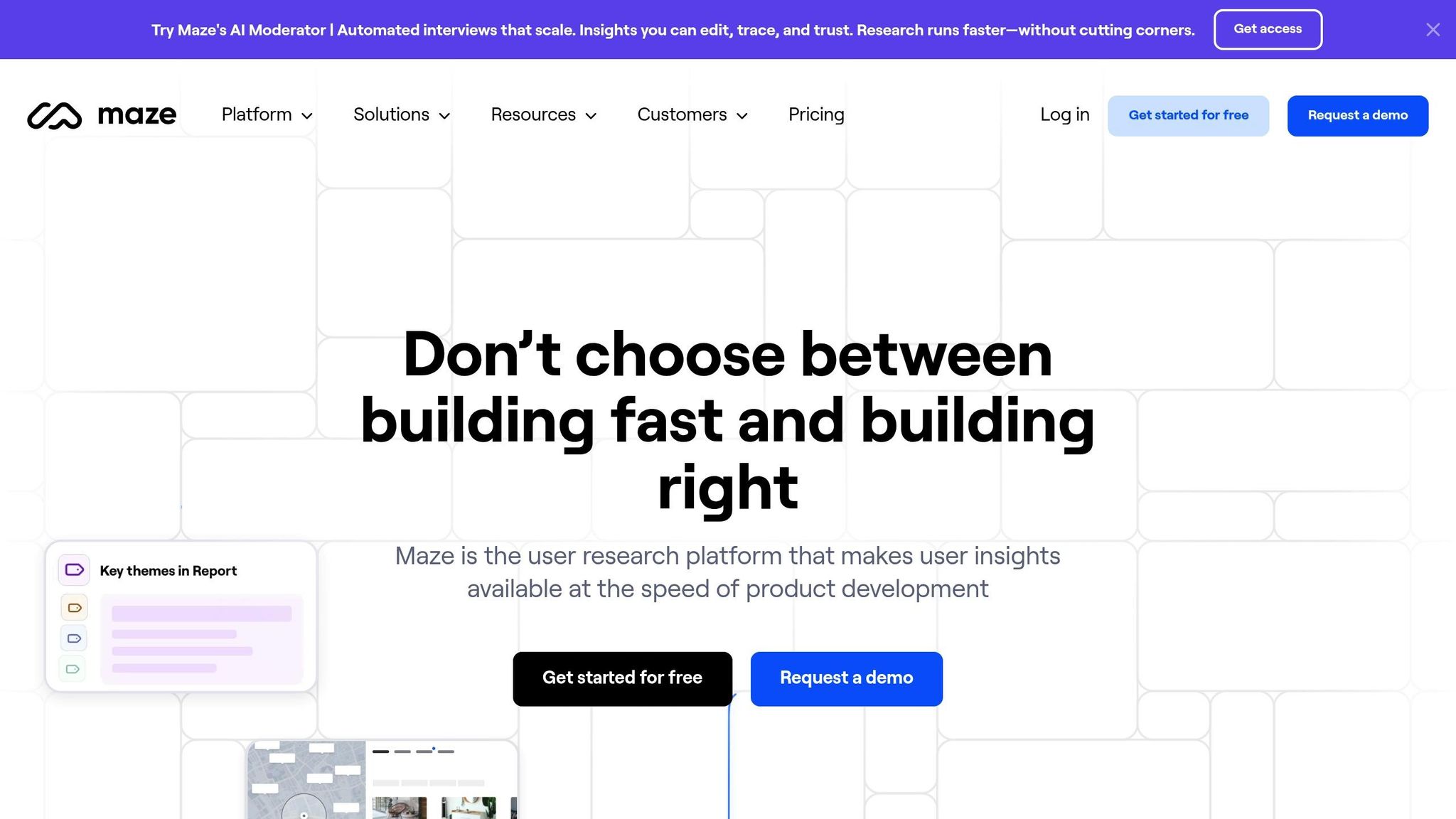
Maze is an AI-powered usability research platform that’s reshaping how teams approach usability testing. With more than 60,000 teams already using its tools, Maze has become a go-to solution for prototype testing.
AI-Powered Analysis and Insights
Maze’s AI doesn’t just collect data - it transforms it. By auto-generating transcripts, summaries, and thematic sentiment filters, it speeds up the analysis process while reducing bias. It can even flag potential issues in your test questions, like bias, poor readability, or grammar errors, and suggest improvements before your study goes live. Plus, its dynamic follow-up questions adapt to participants’ responses, diving deeper into their feedback.
"Maze's AI summarization and analysis is a big step up from other solutions we've tried. The quality of insights generated is mind blowing and makes our interview analysis process much more effective."
– Renee Goulette, User Experience Researcher
In one study focused on a mobile app’s onboarding process, Maze's AI uncovered that only 67% of users completed the flow without confusion. Step 2 was the most common point of drop-off. Heatmaps generated by the platform highlighted areas where users hesitated, while completion times ranged from 45 seconds to 3 minutes. These insights led to targeted recommendations, such as improving button design and enhancing readability.
This level of analysis showcases Maze’s ability to dig deep into usability challenges and provide actionable insights.
Key Features for Usability Testing
Maze simplifies prototype testing by integrating seamlessly with tools like Figma, Adobe XD, Sketch, and InVision. This makes it easy to set up usability tests to assess user interactions and journeys. The platform supports remote testing, allowing participants to complete tasks from their own devices, and even enables testing on live websites. With access to a pool of over three million pre-vetted participants from 130+ countries, gathering diverse feedback is straightforward.
Pricing (in USD)
Maze offers flexible pricing options to suit teams of all sizes:
- Free Plan: $0/month
- Starter Plan: $99/month (includes 1 study per month with 5 seats)
- Organization Plan: Custom pricing
For additional needs, credit bundles are available: 50 credits for $250, 100 credits for $500, and 500 credits for $2,500. Maze also boasts a strong 4.5 out of 5 rating on G2.
Ideal Use Cases
Maze is perfect for teams in need of a platform that blends both quantitative and qualitative research. It’s especially useful for validating designs and identifying usability issues early - whether you’re testing prototypes, running website studies, or analyzing user behavior in detail.
"Maze reduced the time and cost of running usability tests while allowing us to 10x our sample sizes. This efficiency and scale gives us much greater confidence in the precision of our metrics, all while keeping projects fast and more cost-effective."
– Renato Leite, Lead of CX Research Operations
2. UserTesting
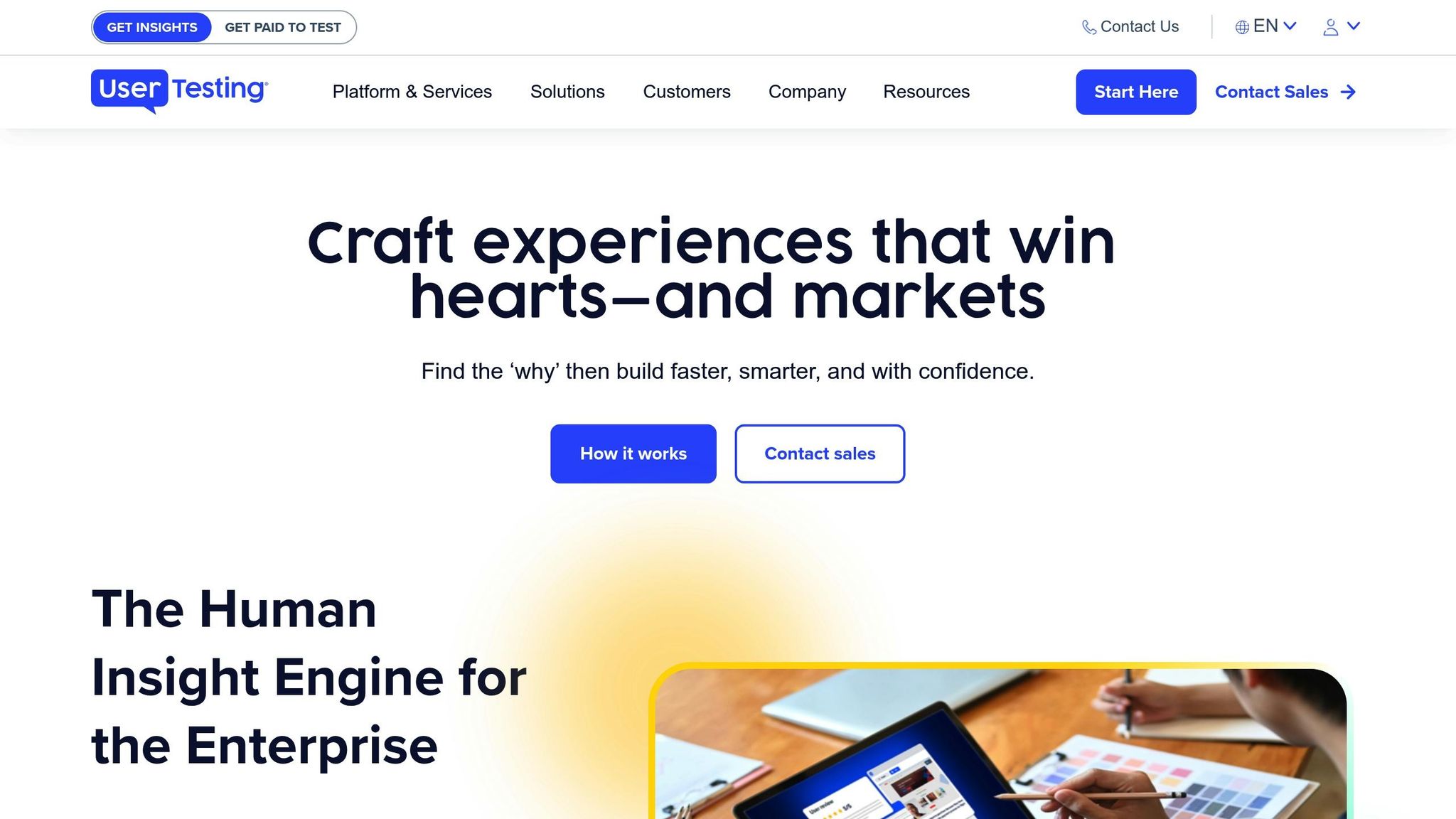
UserTesting combines AI technology with human insights to deliver thorough usability analysis. Since beginning its AI-focused research and development in 2019, the platform has grown into a trusted tool for major brands looking to make faster, data-informed decisions.
AI-Driven Analysis and Insights
UserTesting uses AI to process large amounts of multimedia data, identifying key themes and generating behavioral transcripts from user interactions like clicks and scrolls. Its AI-powered tools, such as AI Insight Summary and AI Survey Themes, stand out. The AI Insight Summary condenses hours of video into actionable takeaways, while AI Survey Themes organizes open-ended responses into clear categories.
In April 2024, the platform introduced its Feedback Engine, which leverages AI to analyze open-ended survey questions at scale, making it easier for businesses to extract meaningful insights.
"Analyzing human insight helps us understand what's important to our customers and what resonates with them in our advertising and marketing materials." – Chief Experience Officer
These AI advancements are designed to integrate seamlessly with various testing scenarios, offering flexibility for diverse applications.
Key Features for Usability Testing
UserTesting supports testing across websites, apps, prototypes, and concepts using its global participant network. It’s designed to address a range of research needs, including marketing validation, product development, digital experience optimization, and UX research. Key features include:
- Journey mapping
- Voice of Customer insights
- NPS and CSAT tracking
- Omnichannel testing
- Accessibility testing
- Validation of creative assets based on audience feedback
The platform accommodates both moderated live sessions and unmoderated tests, ensuring versatility for different research approaches.
Pricing (in USD)
UserTesting offers flexible pricing tailored to enterprise needs, with three subscription tiers: Essentials, Advanced, and Ultimate. Annual subscriptions typically range from $30,000 to $50,000, and individual seats cost between $1,500 and $2,500 per month. While a free trial is available, there’s no permanently free version. UserTesting holds a 4.5 out of 5 rating on G2, though pricing is frequently noted as a concern.
Ideal Use Cases
UserTesting is best suited for enterprises aiming to gain deep insights into user behavior and improve digital experiences. Its strengths lie in early-stage concept validation, uncovering unmet customer needs, and refining features based on real-world feedback. Examples of its impact include:
- Walmart: 13% revenue growth from mobile purchases
- Microsoft: 5X faster decision-making
- Kimberly-Clark: 30X reduction in testing costs
- Wells Fargo: 20+ point improvement in CSAT scores
"Quite simply, we could not have achieved the incredible results we saw without the insights gained through UserTesting. It is by far the most potent weapon in our arsenal." – UX Manager
3. Optimal Workshop
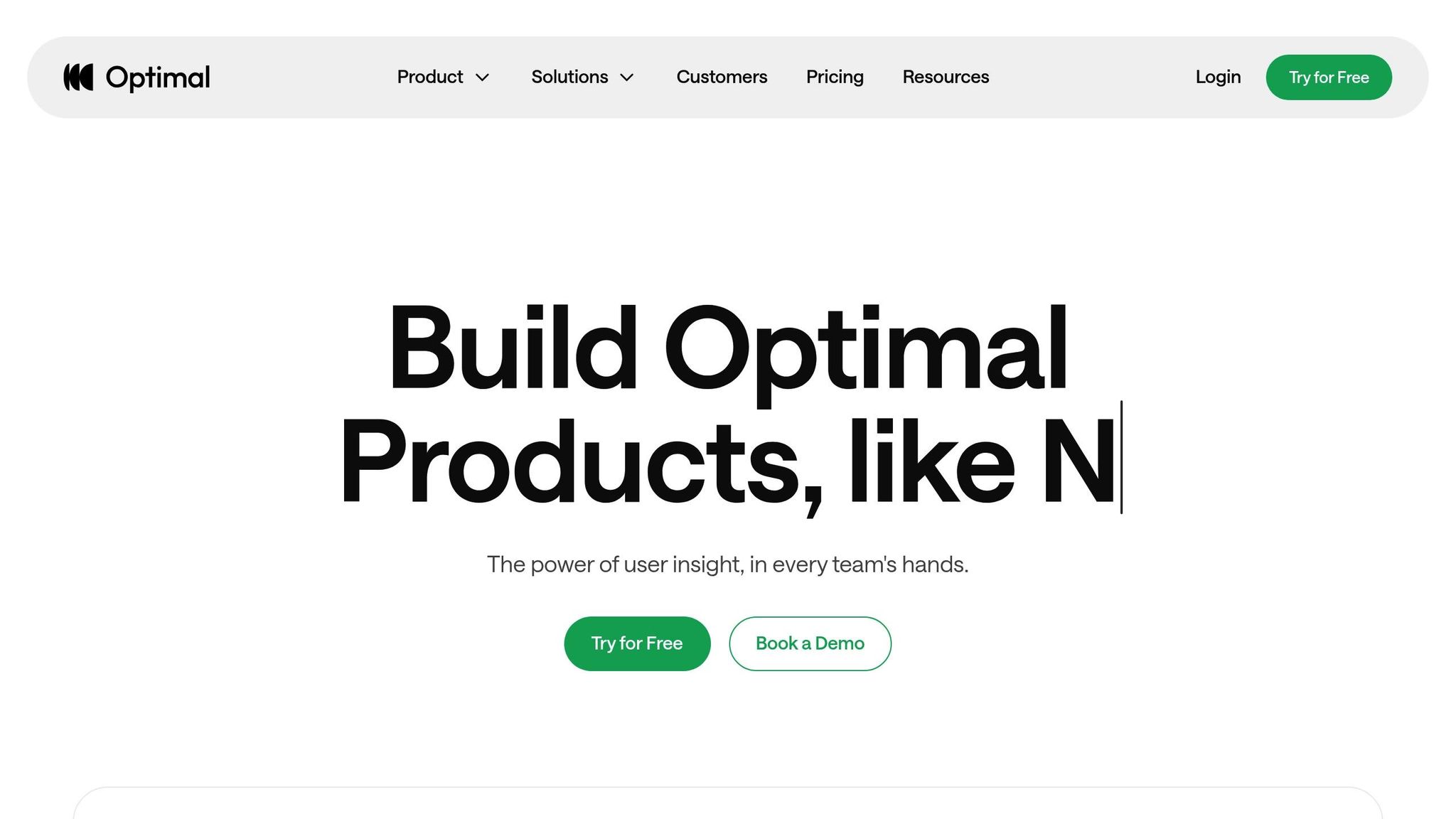
Optimal Workshop is an advanced usability testing platform designed to improve digital interfaces. With over 20 million studies conducted and a reported 93% success rate in enhancing products, it’s a go-to solution for information architecture and user experience research.
AI-Driven Analysis and Insights
This platform leverages AI to identify trends within large usability datasets. For content designers, it provides tools to refine language, navigation, and overall information structure.
Optimal Workshop shines when tackling complex user behavior data, especially through methods like card sorting and tree testing. Building on this strong foundation, the team is developing an AI-powered feature to simplify the wording of intricate survey questions, making it easier for researchers to create studies that yield actionable results.
Richard 'Dice' Allardice, an Information Architect at Xero, shared how these insights reshaped their content strategy:
"Xero is able to answer more queries with content".
Key Features for Usability Testing
Optimal Workshop offers a suite of tools tailored for user experience research, including:
- Treejack: A tree testing tool that identifies where users struggle within content hierarchies.
- OptimalSort: A card sorting tool to uncover how users naturally organize information.
- Chalkmark: A first-click testing tool to evaluate calls-to-action and user behavior paths.
The platform also supports prototype testing to validate design concepts early, surveys to capture user feedback, and a unified interface for qualitative analysis. Setting up a study is quick - taking under six minutes.
By combining AI with precise user insights, Optimal Workshop simplifies usability testing while delivering impactful results.
Pricing (in USD)
The platform offers two main pricing options:
- Starter Plan: At $199 per month (billed annually), this plan includes 5 studies per year, unlimited seats, and unlimited participant responses per study.
- Enterprise Plan: Custom-priced for larger organizations, this plan includes multiple workspaces, administrator controls, usage reports, and access to a dedicated Customer Success Manager.
A 7-day free trial is available, though limited to 2 participants.
Ideal Use Cases
Optimal Workshop is perfect for teams focused on refining information architecture and navigation. It’s particularly useful for:
- Structuring site navigation before interface design.
- Understanding user mental models to prioritize navigation elements.
- Enhancing overall website usability.
Organizations planning major website redesigns or launching new digital products can rely on Optimal Workshop to validate their decisions before committing to visual design and development.
4. Lyssna (formerly UsabilityHub)

Lyssna is a user research platform designed to connect teams with a global pool of participants. With access to over 690,000 users worldwide, it enables targeted user testing to gather valuable feedback. The platform helps transform this feedback into practical design improvements, making it suitable for both seasoned UX professionals and those just starting out.
Leveraging its vast participant base, Lyssna uses AI to swiftly translate data into meaningful insights.
AI-Driven Analysis and Insights
Lyssna’s AI tools simplify the process of turning raw data into actionable insights. By identifying patterns and trends, it helps validate assumptions and guides teams toward better strategies. Madalayne, a verified reviewer from a Health, Wellness, and Fitness company, shared her experience:
"So far, the AI synthesis for qualitative responses works perfectly for generating insight reports quickly."
Key Features for Usability Testing
Lyssna offers a variety of testing methods to refine digital experiences:
- Five-second testing to evaluate landing pages and messaging effectiveness.
- First-click testing to measure navigation success.
- Card sorting to understand how users organize information.
- Tree testing to improve information architecture.
- Preference testing to assess user choices.
It also supports prototype testing with Figma integration and allows flexible participant recruitment - either through Lyssna’s panel or your own users. The platform includes tools for managing interviews, setting up targeted screeners, and recording unmoderated tests with audio, screen, and webcam footage.
Abi, a verified reviewer from Financial Services, highlighted its benefits:
"Lyssna has been a time and budget saver in my organization. It allows me and my team to do moderated and unmoderated usability testing in one place and easily view the results of the testing so I can more efficiently start analysis - thus helping us create better experiences for our customers."
Pricing (in USD)
Lyssna offers pricing options tailored to different team sizes and needs:
- Free Plan: $0/month – Includes tests up to two minutes long, variation sets, and 3 seats.
- Basic Plan: $89/month – Provides unlimited tests and surveys, 5-minute tests, 15 self-recruited interview sessions per month, and 50 GB storage.
- Pro Plan: $199/month – Adds unlimited seats, custom test branding, conditional logic, and granular permissions.
- Enterprise Plan: Custom pricing – Features advanced security, custom MSAs and NDAs, and enhanced administrative controls.
The platform is well-regarded for its value, earning a 4.2/5 rating for cost-effectiveness.
Ideal Use Cases
Lyssna is perfect for teams that need quick user feedback and want to build a habit of regular testing. It’s particularly useful for preference tests, first-click tests, and design surveys that provide fast insights. Rohan, a verified reviewer from Information Technology and Services, shared:
"Our overall experience has been excellent. Lyssna helped us build a habit of user testing early and often. It's reduced rework and design churn, while increasing confidence in our UX decisions. We've seen measurable improvements in onboarding flow completion rates and have been able to present real user data to stakeholders during reviews."
With Forrester Research reporting that every $1 spent on UX yields a $100 return - a 9,900% ROI - Lyssna offers an accessible way for organizations to harness user research for better business outcomes.
5. Loop11
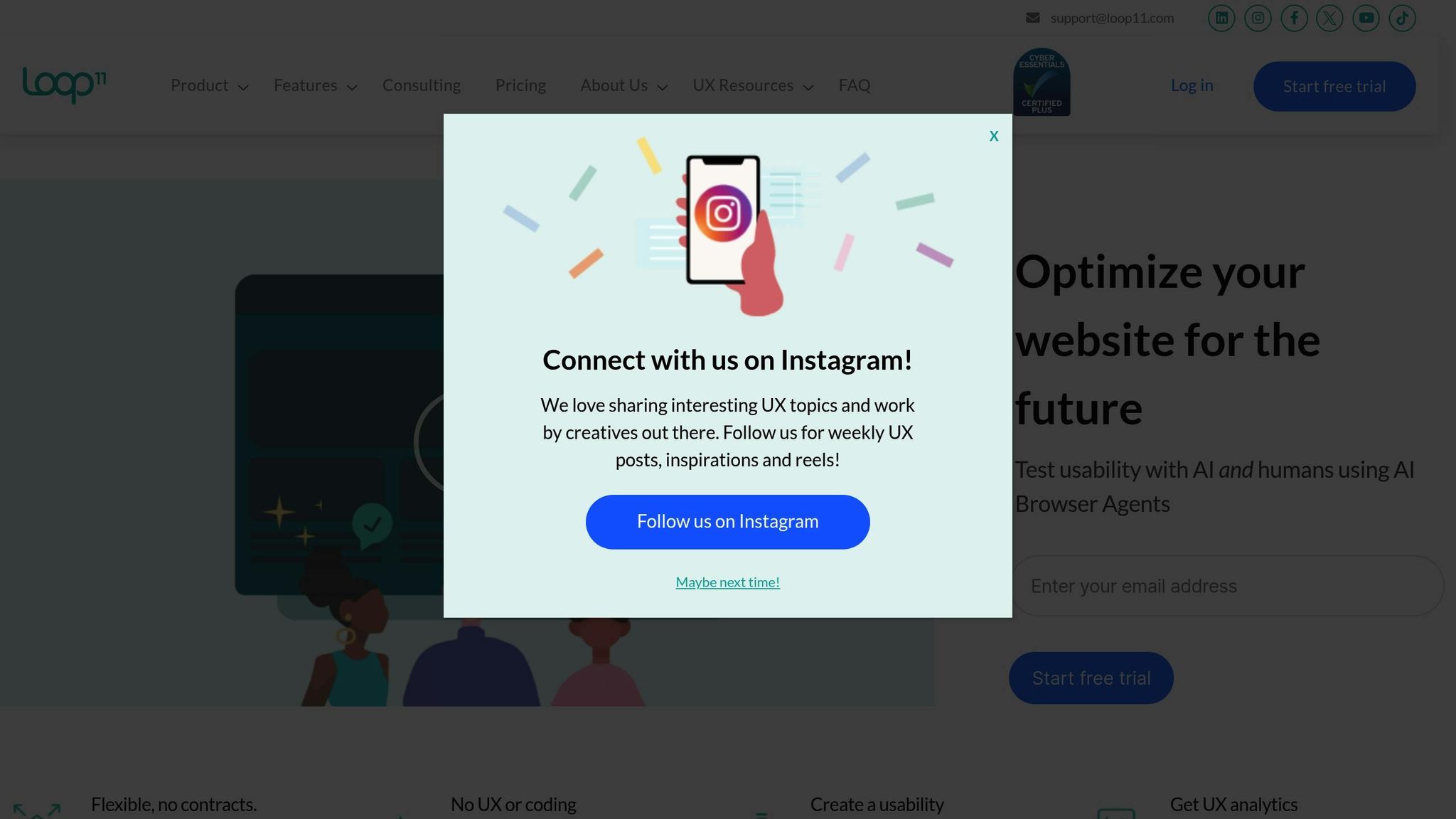
Loop11 is a remote usability testing platform that blends traditional human testing with AI-powered tools, offering a streamlined way to gather and analyze UX insights. What sets Loop11 apart is its use of independent AI testing agents and automated pattern recognition, making it a practical option for teams looking to speed up their research process without sacrificing depth.
AI-Driven Analysis and Insights
One of Loop11's standout features is its AI Insights tool, which uses OpenAI's and ChatGPT's technology to process raw data into clear summaries, participant analytics, and detailed reports. This significantly reduces the time spent on analysis.
Another unique aspect is the AI Browser Agents panel, which includes tools like ChatGPT-4o and Claude 3.5 Sonnet. These agents can independently conduct usability tests, offering a scalable alternative to traditional methods. However, a study from March 2025 revealed that AI agents achieved success rates of just 0–25% on prototype websites with placeholder text, compared to human participants' 62–95%. On other usability tests, AI agents managed 5–21% success rates, while humans achieved 73–87%.
The platform also excels in identifying behavioral patterns and automating parts of the testing process. Teams can even create custom AI prompts to tackle specific UX challenges and receive tailored recommendations for improvements.
With 61% of CEOs reporting that AI has enhanced their ability to optimize customer experiences - and with research suggesting that AI-driven testing can boost conversion rates by up to 30% - Loop11's approach aligns with evolving industry practices .
Key Features for Usability Testing
Loop11 supports a wide range of testing methods, making it a versatile tool for UX research. It allows for both moderated and unmoderated tests on live websites, wireframes, and prototypes, accommodating various stages of the design and development process .
The platform is especially effective for:
- Competitive benchmarking
- A/B testing
- Accessibility assessments
- Search engine findability studies
- Mobile and tablet usability testing
- True intent studies
- Information architecture evaluations
Its reporting capabilities have also drawn praise. As Mashable remarked:
"This remote usability testing tool gives you loads of excellent reporting features!"
Pricing (in USD)
Loop11 offers flexible pricing plans to suit different team sizes and testing needs:
| Plan | Monthly Price | Annual Price | Features |
|---|---|---|---|
| Rapid Insights | $199/month | $179/month | Includes 5 seats, basic testing features |
| Pro | $399/month | $358/month | Includes 5 seats, advanced analytics |
| Enterprise | Custom pricing | Custom pricing | Tailored to team size and specific needs |
A 14-day free trial is available, granting full access to Enterprise features. Additionally, teams switching from other tools can enjoy a 25% discount on annual subscriptions.
Ideal Use Cases
Thanks to its comprehensive features and adaptable pricing, Loop11 is well-suited for various UX research needs. It’s particularly valuable for UX consultancies, agencies, government organizations, educational institutions, and non-profits that require reliable and scalable testing options.
For early-stage projects, AI agent testing can quickly pinpoint major navigation issues before moving on to human testing. It’s also a great tool for fast usability scans and competitive benchmarking, offering consistent and scalable assessments.
Sarai Prado, Lead UX Researcher at Sperientia: [Studio + Lab]®, highlights the platform’s time-saving benefits:
"Loop11 saves us lot of time because we can reach more people than we could if we were doing in-person interviews"
For teams conducting regular testing throughout the development process, Loop11 proves invaluable. Research shows that testing with just five users can uncover 85% of usability issues when done consistently. Fran Jordan, Design and Content Chapter Lead at Vodafone Ireland, underscores the efficiency:
"You should be able to prepare a user test very quickly. With Loop11, we can do that. Whereas traditionally, there was a lot of prep time for user tests, and you'd recruit users and invite them in. Loop11 is a very quick way to validate a design".
6. Hotjar
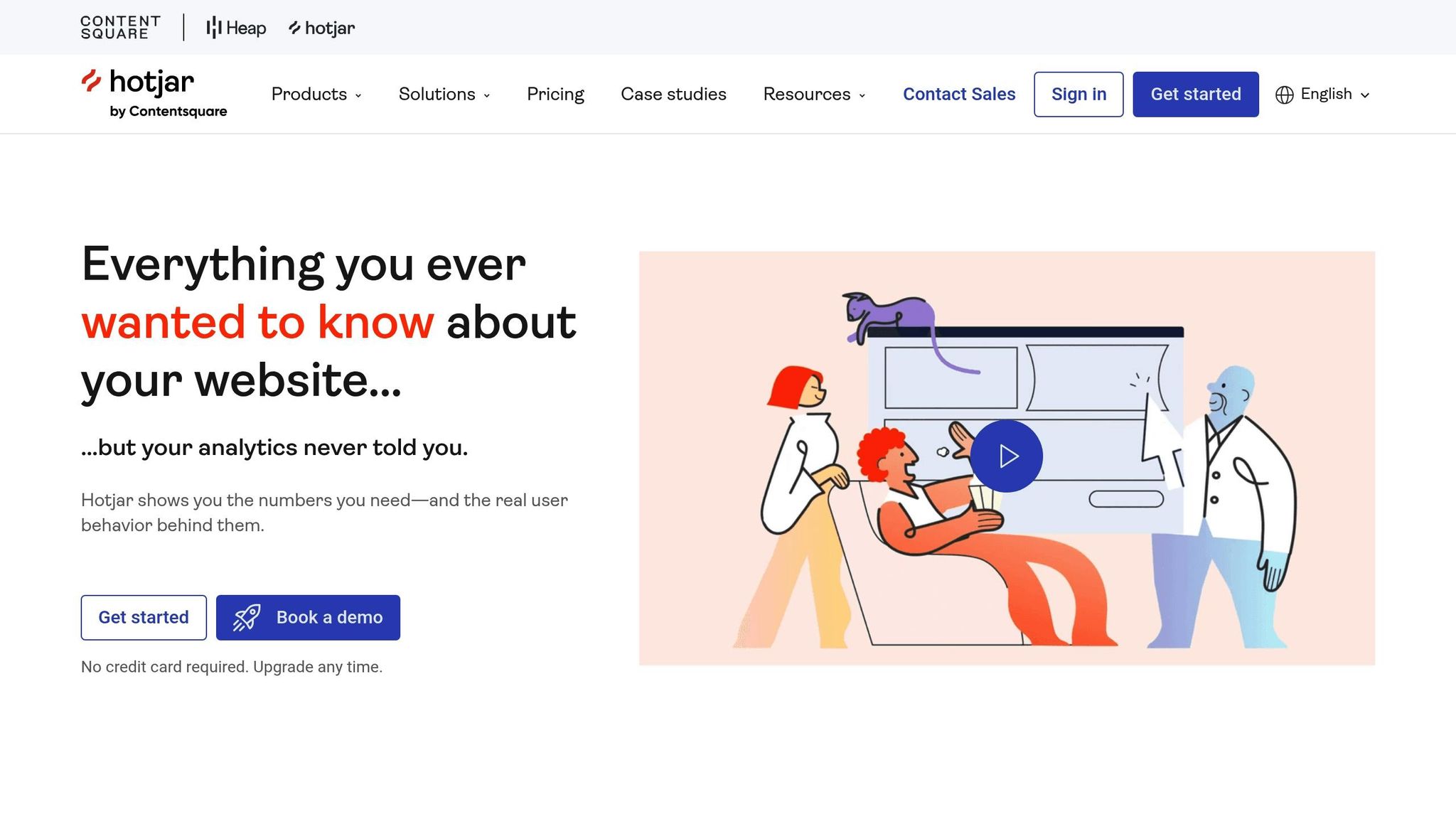
Hotjar is a comprehensive behavior analytics platform that integrates AI-powered usability testing tools into a single solution. Trusted by over 1.3 million websites across 180+ countries, it’s become a go-to resource for teams aiming to understand user behavior through visual data and automated analysis.
AI-Driven Analysis and Insights
Hotjar leverages AI to turn traditional heatmaps and session recordings into actionable insights. Instead of sifting through hours of data, the platform automatically identifies usability issues that might otherwise slip through the cracks.
- AI-Powered Heatmap Segmentation: Pinpoints problem areas like rage clicks, dead clicks, and scroll drop-offs, helping teams locate where users face friction.
- Automated Friction Detection: Highlights frustration signals in real-time, such as repeated form submissions, erratic cursor movements, or prolonged hesitation. This eliminates the need for manual analysis of user sessions.
- Predictive Analysis & Behavior Clustering: Groups user sessions based on shared behaviors like cart abandonment or repeated hovering. This allows teams to spot patterns across user segments and focus on high-impact fixes.
These features give teams a clear roadmap for improving user experience. For instance, an eCommerce company used Hotjar to optimize their checkout process. The AI flagged rage clicks on the "Apply Coupon" button, and session recordings showed users repeatedly clicking without a response. Heatmaps revealed dead clicks near the promo code field. After introducing an instant validation message for invalid codes, the company saw a 17% increase in completed checkouts within just 30 days.
Key Features for Usability Testing
Hotjar simplifies usability testing by offering a range of tools on one platform. Visual heatmaps provide insights into where users click, scroll, and linger, revealing both what users do and why they do it. Additional tools like first-click testing and conversion funnels help track where users drop off, making it easier to identify and fix weak points in the user journey.
The platform also excels at gathering direct user feedback. Customizable surveys and real-time feedback widgets allow teams to collect valuable insights straight from users. With over 402 million survey responses collected, Hotjar has refined methods for understanding user needs. The AI for Surveys feature speeds up the process by generating surveys and summary reports automatically.
Michael Aagaard, Senior Conversion Optimizer at Unbounce, praises this all-in-one approach:
"I used to have a bunch of different tools I had to pay for, but with this platform you get everything in one bundle".
Pricing (in USD)
Hotjar offers tiered pricing for its three products - Observe, Ask, and Engage. These can be purchased individually or bundled for a more complete solution.
| Plan | Observe | Ask | Engage |
|---|---|---|---|
| Basic (Free) | $0 (35 daily sessions) | $0 (20 monthly responses) | $0 (3 interviews/month) |
| Plus | $39/month (100 daily sessions) | $59/month (250 monthly responses) | $49/month (36 interviews/year) |
| Business | $99/month (500 daily sessions) | Included with Observe | Included with Observe |
| Scale | $213/month (500+ daily sessions) | $159/month | Custom pricing |
Annual subscribers get a 20% discount, and those subscribing to two paid plans simultaneously receive an additional 10% discount. Even the free Basic plan includes access to Hotjar AI for Surveys . This flexible pricing makes it easier for teams of all sizes to access powerful usability tools.
Ideal Use Cases
Hotjar is perfect for teams seeking a deep understanding of user behavior without juggling multiple tools. It’s particularly effective for eCommerce businesses, where optimizing checkout flows and product pages can directly boost revenue.
Eric Peters, Growth Marketer at HubSpot, shares one of the platform’s strengths:
"If you can't figure out why users are bouncing, Surveys is a really direct way to ask them".
The platform also shines for product teams conducting usability tests during development cycles. Its AI-driven analysis allows teams to uncover insights quickly, even with limited resources. For those focused on improving conversions, Hotjar’s blend of behavioral data and direct feedback delivers the clarity needed to make informed design decisions.
sbb-itb-9a5c6df
7. Trymata
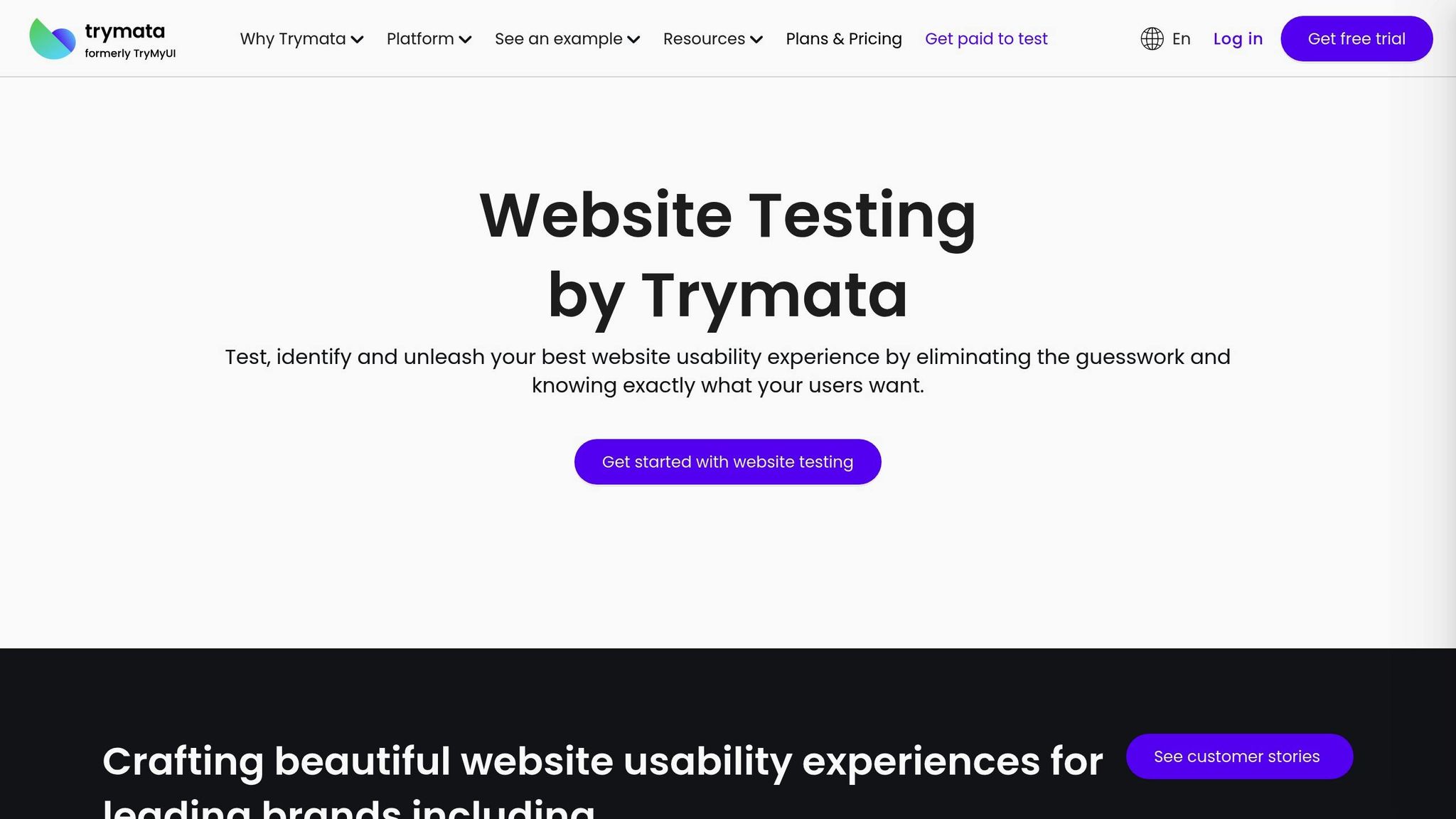
Trymata, previously known as TryMyUI, is a remote usability testing platform that blends traditional methods with AI-driven automation. It’s designed to support product, UX, and marketing teams - whether they’re part of a budding startup or a global enterprise - in crafting digital experiences that drive revenue, engagement, and growth.
AI-Driven Analysis and Insights
Trymata integrates AI into its testing process to streamline tasks that were once manual. Its standout AI features include automatic test script creation, which generates testing scenarios tailored to specific goals, and an automated data tagging system that processes user sessions to highlight and rank critical UX findings. These tools allow teams to work more efficiently, gain sharper insights, and establish smarter workflows. This AI-powered approach enhances the platform’s already extensive suite of testing tools.
Key Features for Usability Testing
The platform simplifies remote usability testing by combining screen recording with analytics for websites, desktop applications, and mobile apps (both Android and iOS). Key features include:
- Session recordings with transcripts: These make it easy to search for feedback and share findings with your team.
- Moderated and unmoderated testing: Choose between guiding participants in real time or letting them complete tasks independently.
- Participant recruitment options: Tap into Trymata’s participant pool or use your own testers to match your target audience.
- Post-test surveys and usability metrics: Evaluate user experience using tools like the System Usability Scale (SUS) and Net Promoter Score (NPS).
- Heatmaps and conversion funnel analysis: Understand user behavior and identify areas for improvement.
- Collaboration tools: Shared logins, video annotations, and highlight reels make teamwork seamless.
These features are backed by user feedback. Jordan Becker, Usability Specialist at Gallup, emphasizes the impact of Trymata’s tools:
"There's nothing more impactful than showing a video clip to stakeholders. It makes everything click. They really see that it's real people and real problems that we're dealing with."
Pricing (in USD)
Trymata’s paid plans start at $399 per month. These plans include features like full data export, tools for sprint testing, and the ability to upload custom NDAs to safeguard your brand during testing.
Ideal Use Cases
Trymata is highly effective for testing websites, apps, and eCommerce platforms. It’s perfect for identifying pain points in customer journeys through unmoderated sessions. Product teams can test prototypes, live websites, or mobile apps in realistic scenarios. The platform’s first impression testing captures users’ initial reactions, while task-based testing evaluates specific user journeys.
Jeffrey Kuo, Lead Product Designer at Luxottica, highlights how Trymata supports design decisions:
"When I make design recommendations, having data from Trymata allows me to ground them with hard evidence. It makes my points a lot more solid – I'm able to say, '4 out of 5 people struggled here, 5 out of 7 people couldn't do this.' With Trymata, I get the ammo I need to defend my design decisions."
StubHub’s product team has also benefited from Trymata’s insights. Parag Vaish, Director of Mobile Product Management, shared:
"The honest, raw feedback we got through Trymata helped us set aside our biases and prioritize our roadmap based on what our customers really wanted."
8. Axe DevTools
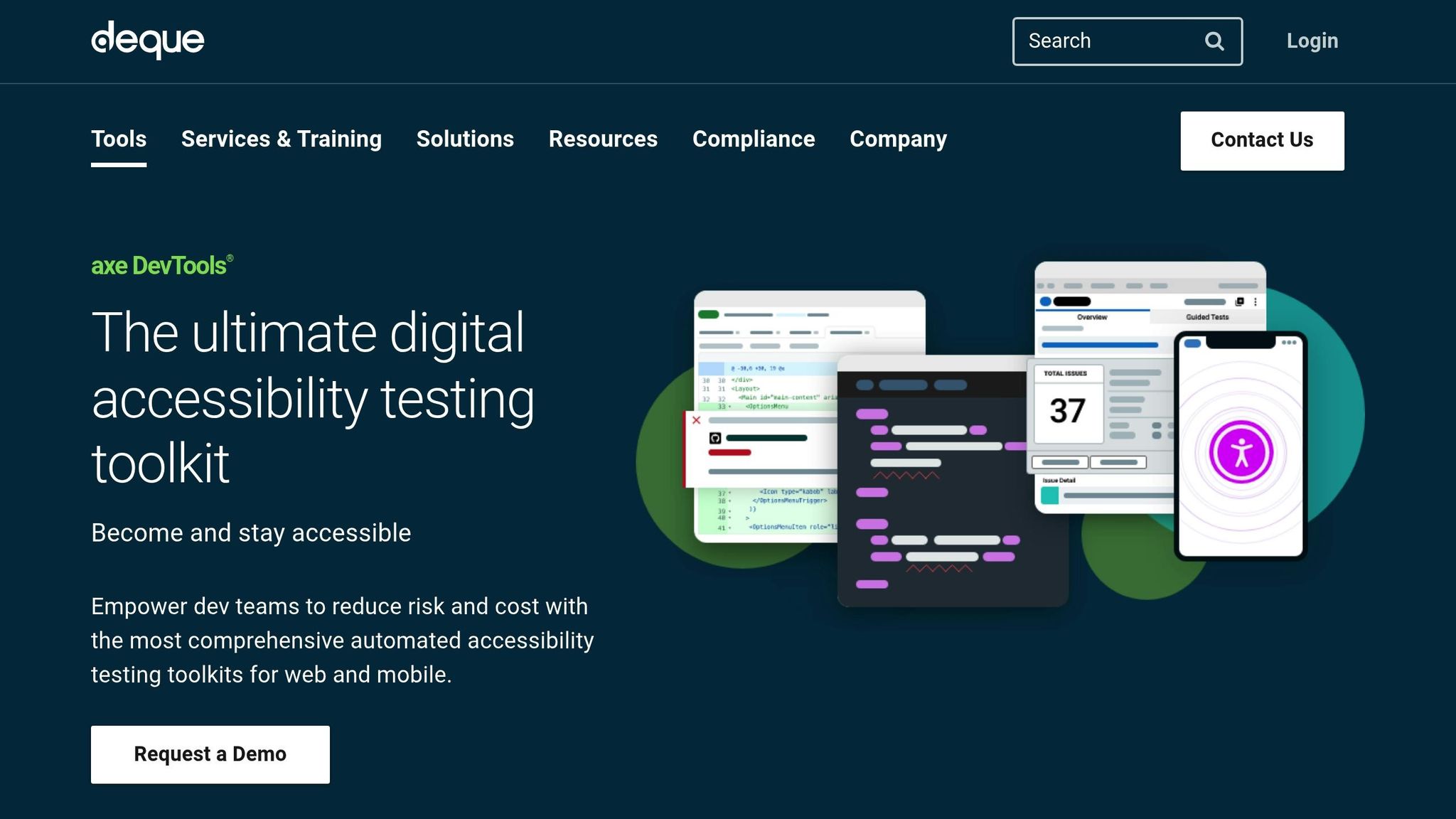
Axe DevTools is a powerful accessibility testing tool designed to help development teams tackle digital accessibility challenges effectively. Created by Deque Systems, it draws on two decades of data to provide precise, actionable insights that streamline the testing process.
AI-Driven Analysis and Insights
With over 20 years of accessibility data and millions of tested defects under its belt, Axe DevTools uses advanced machine learning and computer vision to analyze complex elements like data tables, forms, and interactive components. It even employs OCR (Optical Character Recognition) to ensure text accuracy and verify color contrast compliance .
The tool's Intelligent Guided Tests (IGTs) leverage AI to spot issues that traditional automated tests might miss. By combining computer vision and syntax analysis, IGTs guide users through compliance checks with simple, clear questions - no specialized expertise required.
What sets Axe DevTools apart is its ability to prioritize issues based on their impact, frequency, and relevance to user behavior. This approach ensures teams focus on the most critical barriers first, making accessibility testing not just thorough but also efficient. Plus, it integrates seamlessly into various development workflows, making it a valuable addition to any team’s toolkit.
Key Features for Usability Testing
Axe DevTools supports testing across all development environments, coding languages, and CI/CD tools. It can be used at various stages: directly within the IDE, interactively in the browser, or during pull requests via CI/CD pipelines.
Here’s what it offers:
- Real-time issue detection: Instantly identifies accessibility problems while coding.
- Detailed remediation guidance: Provides clear instructions to fix detected issues.
- Dynamic content management: Handles complex, interactive elements like forms, buttons, and navigation menus.
- Compliance testing: Covers WCAG 2.1 Level A, AA, and AAA standards, as well as Section 508 requirements.
The platform’s automated testing can catch up to 80% of web accessibility issues. For the remaining gaps, Intelligent Guided Tests step in to uncover problems that automation alone might miss. It even supports mobile app testing interactively, without needing access to the source code.
Pricing (in USD)
Axe DevTools offers flexible pricing options to suit different team sizes and requirements:
- Free: Includes fully automated testing and remediation guidance, available indefinitely.
- Pro: Priced at $45 per user per month, this tier adds features like Intelligent Guided Tests, AI-powered capabilities, component-level testing, issue exporting, and live support.
- Enterprise: Custom pricing for larger teams or organizations, with features like on-premise installation, no-code automated testing, APIs, end-to-end tests, Git-aware reports, and mobile app testing.
Ideal Use Cases
Axe DevTools is designed for a broad audience, including web and mobile developers, test engineers, and project leaders. It’s especially useful for organizations managing large web portfolios, offering centralized dashboards to monitor compliance. Industries like finance, healthcare, and government - where accessibility is a legal and operational priority - will find this tool indispensable.
Development teams benefit from features like issue deduplication, tracking code changes, and enforcing accessibility policies at scale. And because Axe DevTools doesn’t require developer involvement or source code access, it’s also accessible to QA teams, designers, and content creators.
"Axe DevTools helps your web and mobile dev teams catch accessibility errors while coding, dramatically reducing the time and cost of manual testing down the line."
- Deque Systems
9. Tricentis Testim
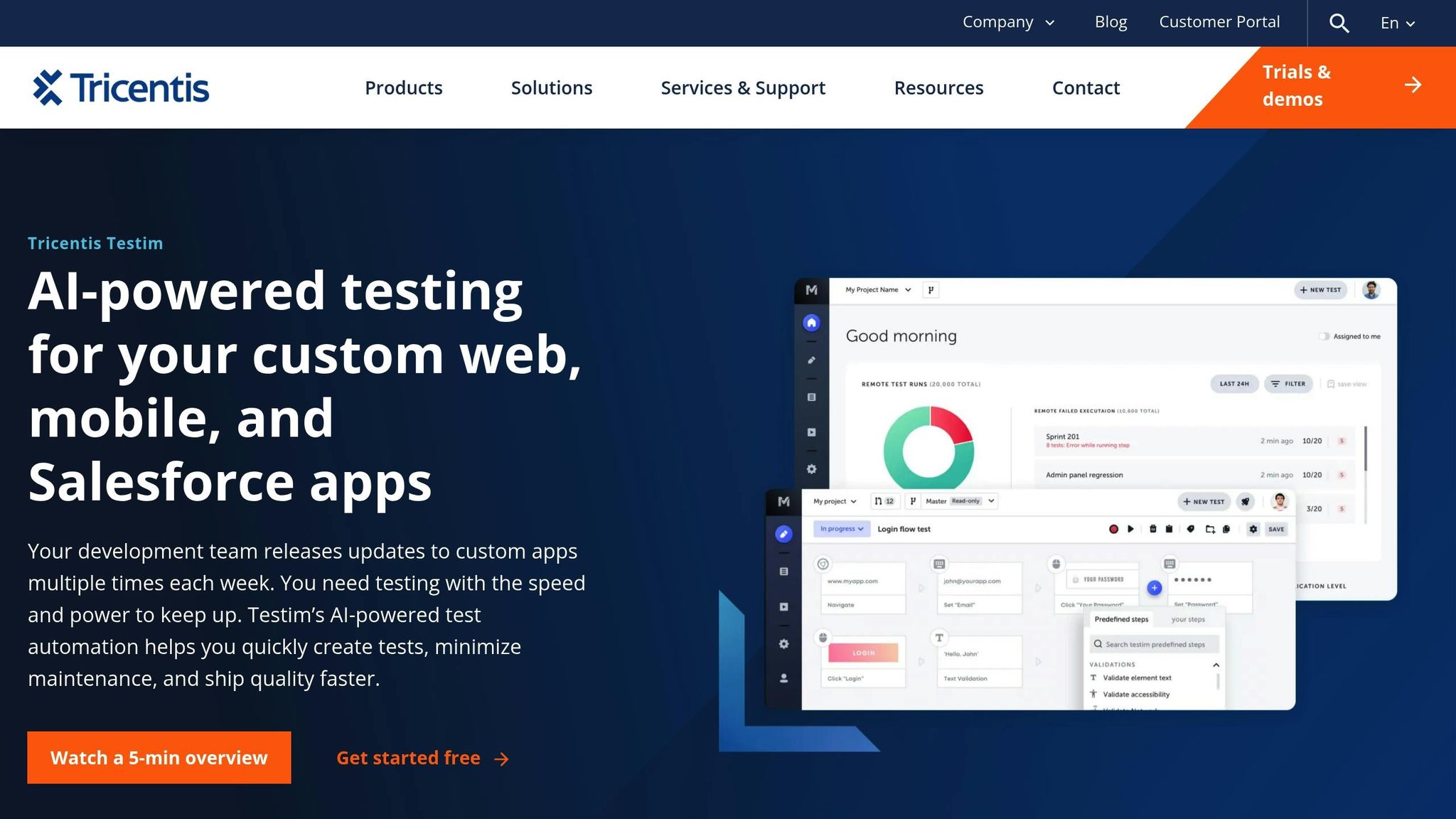
Tricentis Testim uses artificial intelligence to simplify usability testing, offering a platform that adapts to evolving applications while minimizing the time spent on manual test maintenance. Built for modern teams, it combines AI-driven automation with practical tools to address common testing challenges.
AI-Driven Analysis and Insights
Testim's AI features include smart locators that learn from your application and adjust selectors automatically with each new version. It also provides self-healing tests that adapt to interface changes, reducing the need for constant updates. To combat flaky tests, AI-powered stabilizers handle dynamic content, slow-loading elements, and shifting page layouts intelligently. When issues occur, the AI identifies potential fixes and updates locators, significantly lightening the maintenance workload.
The platform also includes Testim Copilot, which uses generative AI to speed up workflows, debug problems, and create detailed documentation. This aligns with industry trends, as 61% of organizations now favor generative AI for tasks like code generation and auto-completion, while 75% actively invest in AI to enhance QA processes. Additionally, Testim’s Enhanced Mode eliminates the need for testers to configure tests based on an app's tech stack, making it easier to use than traditional methods. For example, Outbrain reported a 95% reduction in test authoring time thanks to these features.
These AI-driven tools form the foundation for a robust and efficient testing experience.
Key Features for Usability Testing
Testim supports testing for web, mobile, and Salesforce applications, providing a unified platform for varied needs. Its standout features include smart waits and dynamic selectors, which replace fragile static waits with intelligent timing mechanisms. Advanced reporting tools allow QA engineers to trace failures back to specific UI elements or network calls. To further enhance test reliability, the platform includes smart recovery features like conditional waits, dynamic retries, and self-healing selectors.
Integration is seamless, connecting Testim to other Tricentis solutions like SeaLights and qTest to streamline testing efforts. It also integrates easily into CI/CD pipelines, making it an excellent choice for DevOps workflows. Users often see a 60% boost in test coverage and a 50% cut in testing time. Notably, 63% of enterprises cite maintaining test scripts for changing UIs as their biggest challenge, which Testim effectively addresses.
Pricing (in USD)
Testim uses a usage-based pricing model that scales with team requirements:
- Basic Plan: $450 per month, offering essential AI-powered testing features .
- Pro Plans: Custom pricing available through consultation with Tricentis.
- Free Trial: Available for teams to explore the platform before committing to a paid plan.
The platform is well-rated by users, earning 4.6 out of 5 stars for value for money, based on 50 reviews .
Ideal Use Cases
Tricentis Testim is especially effective for teams managing complex web applications with frequently changing UIs. Companies like Microsoft Cyber Defense have used Testim for end-to-end testing, while TreviPay leveraged its AI-driven capabilities to accelerate cloud transformation. The platform also lowers the technical barrier for test creation, allowing non-technical team members to contribute. As one customer noted, Testim's accessibility makes it far easier to use than traditional Selenium-based tools. For teams dealing with flaky tests and high maintenance demands, Testim's self-healing features offer a smart solution, improving over time by learning from past executions.
"I love how Tricentis Testim simply reduces the time to write test and improves test stability. The best thing about it is that it uses AI and it learns from the previously executed steps and improves itself without the human intervention." - Gartner Peer Insights Reviewer
10. Katalon TestOps
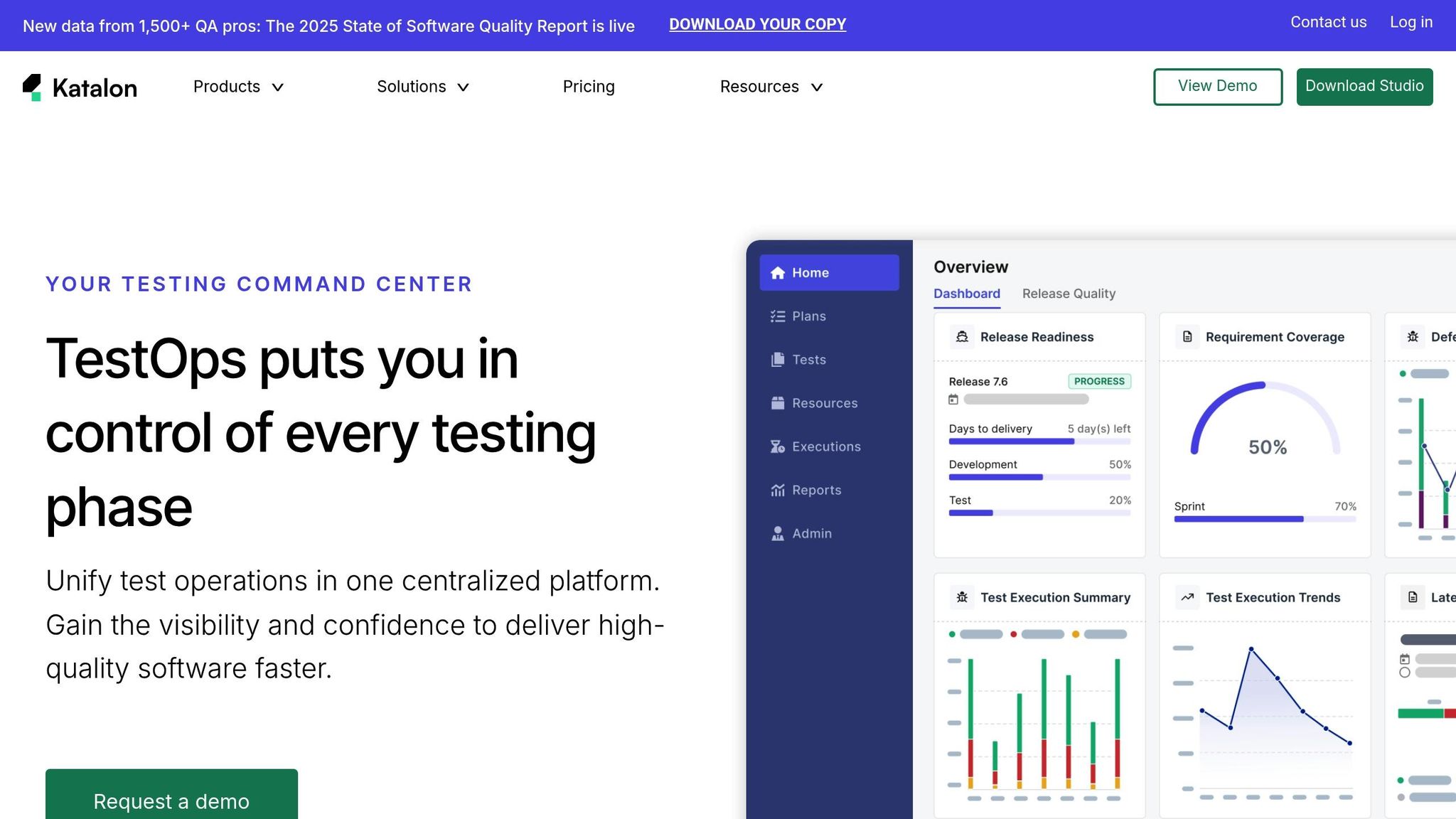
Katalon TestOps brings manual and automated testing together under one roof, with the added advantage of AI-driven analytics. It’s built to simplify workflows across web, mobile, and API testing, helping teams go beyond basic automation to gain deeper insights into software quality. Let’s take a closer look at what makes this platform stand out.
AI-Driven Analysis and Insights
One of the standout features of Katalon TestOps is its Virtual Data Analyst, which transforms raw testing data into actionable insights and tailored recommendations. This tool helps teams pinpoint where to focus their attention for maximum impact.
The platform also shines in failure analysis. It automatically categorizes failed test cases by their root causes and suggests corrective actions. With real-time tracking, teams can debug issues more efficiently while keeping an eye on overall test quality, release readiness, and project progress. Additionally, pre-built reports covering metrics like quality, coverage, and release readiness make data-driven decisions easier.
Key Features for Usability Testing
Katalon TestOps provides a centralized hub for test requirements, execution, and integrations, offering complete visibility and fostering collaboration. Teams can link project requirements and milestones directly to test cases, ensuring that testing efforts align with business goals.
The platform integrates effortlessly with existing testing tools, CI/CD systems, and environments, making adoption straightforward for teams with established workflows. Its real-time collaboration capabilities allow developers, testers, and IT professionals to work together seamlessly, addressing bottlenecks as they arise.
Pricing (in USD)
Katalon TestOps offers flexible pricing tiers to suit different team sizes and needs:
- Basic Plan: $54 per user per month
- Premium Plan: $183 per user per month, billed annually at $2,199
- Ultimate Plan: Custom pricing for enterprise-level features and dedicated support
The Premium plan is ideal for teams scaling up their test automation, while the Ultimate plan is tailored for larger organizations with extensive testing needs. For the Ultimate plan, contact Katalon’s sales team for pricing details.
Ideal Use Cases
Katalon TestOps is a strong fit for organizations of all sizes looking to streamline their testing processes and speed up the delivery of high-quality applications. It’s particularly useful for teams that prioritize smooth collaboration. For projects involving complex testing across web, mobile, and API environments, the platform consolidates scattered tools into one unified system, simplifying management and boosting efficiency.
Tool Comparison Chart
Here's a handy chart summarizing the key features, pricing, and strengths of the tools we've reviewed. It’s designed to help you quickly identify which option aligns with your team’s goals and budget.
| Tool | AI Capabilities | Pricing (USD) | G2 Rating | Key Strengths | Best For |
|---|---|---|---|---|---|
| Maze | AI-powered insights, automated data analysis | Free option; Paid plans from $99/month | 4.5/5 | Intuitive design, Figma integration, interactive reports | Prototype testing, small to medium teams |
| UserTesting | Advanced targeting, instant insights | $1,500-$2,500/seat/month | 4.5/5 | Large participant pool, controlled testing environment | Enterprise-level research, in-depth studies |
| Optimal Workshop | Automated analysis, smart recruiting | $199/month | 4.5/5 | Massive user panel (50+ million), easy-to-use interface | Card sorting, information architecture testing |
| Lyssna | Open text analysis, click visualizations | Free for 2-min tests; Paid plans from $89/month | 4.2/5 | Multiple test types, unlimited participants | Visual feedback, design validation |
| Loop11 | GPT-4 powered summaries, AI transcripts | $199-$399/month | 3.6/5 | Versatile testing methods, AI-driven insights | Qualitative and quantitative research |
| Hotjar | Automated heatmaps, session analysis | $39/month | 4.3/5 | Simple setup, unlimited storage, session recordings | Behavioral analysis, conversion optimization |
| Trymata | AI-based analysis, automated insights | $399/month | 4.3/5 | Custom NDAs, highlight reels, team collaboration | Mobile app testing, prototype validation |
| Axe DevTools | Automated accessibility testing, AI-driven bug detection | Free option; Pro plans from $45/user/month | N/A | Accessibility compliance, developer-focused tools | Accessibility testing, compliance requirements |
| Tricentis Testim | Self-healing tests, AI-stabilized automation | Starting at $450/month | N/A | Quick test creation, reduced maintenance | CI/CD integration, web and mobile app testing |
| Katalon TestOps | AI-enhanced test data analysis | $54-$183/user/month | N/A | Unified testing platform, real-time collaboration | Cross-platform testing, enterprise workflows |
Key Takeaways:
- Pricing: Tools like Maze, Lyssna, and Hotjar stand out as budget-friendly options, offering free plans or affordable entry points. On the other end, enterprise-grade tools such as UserTesting and Optimal Workshop cater to larger budgets, delivering extensive features and scalability.
- AI Features: The AI capabilities vary significantly. For instance, Loop11 utilizes GPT-4 for summaries, while Tricentis Testim focuses on AI-stabilized automation to reduce maintenance. Katalon TestOps, meanwhile, provides a centralized platform for seamless test management.
- Team Fit: Smaller teams and startups might lean toward tools like Maze or Hotjar for their cost-effectiveness and simplicity. Enterprises with complex testing needs may find robust solutions in UserTesting or Tricentis Testim.
AI-powered testing tools have proven to cut test maintenance time by up to 70% and reduce escaped UI bugs by over 50%. Considering the U.S. AI market, which was valued at $103.7 billion in 2022 and is expected to reach $594 billion by 2032, it's clear that investing in the right tool is crucial for long-term growth.
For a deeper look into each tool's features and user experiences, refer back to their detailed descriptions. For example, Hotjar’s behavioral analysis tools make it a standout for conversion optimization, while Maze offers an excellent balance of features for prototype testing.
Final Thoughts
After diving into the top tools, one thing is crystal clear: picking the right tool has become a game-changer for success. AI usability testing has reached a pivotal moment. Back in 2025, 57% of organizations were already leveraging AI to boost testing efficiency, and nearly 90% had plans to increase their investments within the following year. The numbers don’t lie - the global AI in test automation market is skyrocketing. It jumped from $600 million in 2023 and is expected to hit $3.4 billion by 2033, with an impressive annual growth rate of 19%. By 2027, experts predict AI will power 80% of enterprise software testing, a massive leap from just 20% in 2022.
When it comes to choosing the right tool, it’s all about aligning with your team’s size, budget, and specific needs. For smaller teams, tools like Maze and Hotjar are fantastic starting points, offering free plans and budget-friendly pricing. On the other hand, larger organizations may find platforms like UserTesting and Optimal Workshop better suited, thanks to their scalability and advanced features.
One of AI’s biggest perks? Cost savings. AI tools can cut testing expenses by up to 30%, which is a huge win for teams under pressure to deliver quality results on tight deadlines. A smart way to get started is by taking advantage of free trials or freemium versions most platforms offer. This lets you test the waters and evaluate how well the tool aligns with your goals - whether it’s improving conversion rates, validating prototypes, or ensuring accessibility.
Another bonus of AI tools is the time they free up. By automating manual tasks, teams can shift their focus to more strategic efforts, like expanding test coverage or diving deeper into customer insights.
If you’re eager to explore even more options, check out TheShed.io. This resource hub offers a wide range of tools across AI, productivity, and development categories, helping you find solutions that work seamlessly with your usability testing platform.
Start small with a trial, define your goals, and gradually scale up your AI testing efforts to drive ongoing UX improvements.
FAQs
What makes AI usability testing tools different from traditional methods?
AI usability testing tools leverage machine learning to process vast amounts of data, conduct multiple test scenarios at once, and adjust to user behaviors in real-time. This approach minimizes human error, accelerates testing, and cuts down on resources compared to older, manual methods.
Traditional usability testing often depends on manual efforts or pre-designed scripts, which can be time-consuming and rigid. In contrast, AI-powered tools are flexible and fast. They excel at spotting trends, anticipating user preferences, and delivering practical recommendations - perfect for businesses aiming to refine their user experience quickly and accurately.
What should I look for when choosing an AI usability testing tool?
When choosing an AI usability testing tool, focus on ease of use. Look for a platform with an intuitive interface that’s accessible for both researchers and stakeholders. It should align with your team’s workflow, whether you’re running frequent tests or managing large-scale, global research projects.
Key features to prioritize include automation, AI-powered insights, and seamless integration with your current tools. The ideal tool simplifies your usability testing process while providing results that directly support your team’s objectives.
Do these AI usability testing tools work with existing design and development workflows?
Most AI usability testing tools in 2025 are designed to fit seamlessly into your existing design and development workflows. They typically support widely-used design platforms like Figma and Adobe XD, as well as automation frameworks such as Selenium, Cypress, and Playwright.
This level of compatibility allows you to integrate usability testing smoothly without needing to replace your current tools or processes, helping to improve both collaboration and automation efficiency.
.svg)
